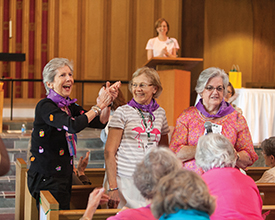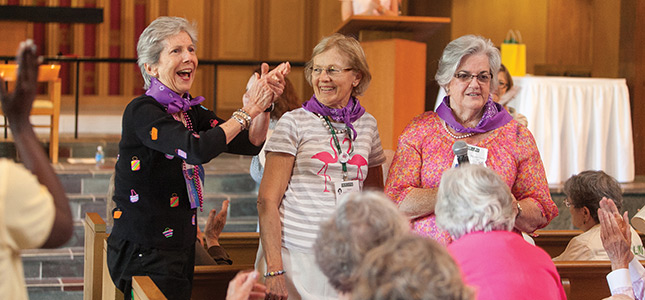
Focus on Philanthropy

Sarah Holland, Suzie Reno, and Suzanne Taylor deliver the news about their class’s record-breaking gift.
Fabulous and relentless
Three 1964 alumnae were the driving force behind the class’s record-breaking 50th reunion gift
By Laura Tuggle Anderson ’98
[quote float=”left”]She’s fabulous, I’m shameless… and I’m speechless![/quote]
Listening to 1964 classmates and 50th reunion leaders Suzanne McCormick Taylor (the fabulous one), Suzie McKnight Reno (the shameless one), and Sarah Holland (the speechless one, natch) is like sitting in on a high-stakes board meeting with confetti and streamers flying around. How did they get 67 of their classmates to attend reunion, and 72 percent of the class to contribute to the total class gift of $1,058,603?
It helps that two of the three have been professional fundraisers, and the third an active fundraising volunteer. But there are other keys to their success, which they shared with us.
Suzanne McCormick Taylor: Suzie and I knew that eventually we would have a million-dollar goal. But we could not tell the class in advance, because it might have scared them to death.
Sarah Holland: What I think is so amazing is the effort that Suzie and Suzanne made to create this record-breaking attendance, participation, and money outcome was not just a result of their personal strength and charisma, but they amassed a really large committee of people who did not all know each other. They had enough reach to connect to all cells of the class; it really was “each one reach one.”
Taylor: We always emphasized that every gift was important. For some people, a $25 gift is a sacrificial gift, and it’s valued.
Holland: You want to get people to make a stretch gift—at whatever amount is a stretch for them.
Taylor: You have to have loving cultivation. And a relentless willingness to revisit the ask [for a gift]. And Suzie did that over and over.
Suzie McKnight Reno: But not being overbearing.
Holland: You have to understand women donors. Women don’t do things at the last minute. They are patient. They want to plan and understand what kind of a difference their philanthropic dollars will make. Some women donors are turned off by competition.

Suzanne Taylor drew Pearl the Flamingo at their 25th reunion in 1989, scribbling frantically in her hotel room because the class had no banner ready for the parade the next day. The “sassy and classy” flamingo wearing pearls represents the women of ’64: “Flamingoes are strong, brave, adaptive, beautiful birds and travelers who flock together,” says Taylor, “so the symbol seemed an appropriate choice
Taylor (to Holland): You put the words to it: “Promote Hollins, give to our class gift, come to reunion.”
Reno: I started back in 2011, at the 1842 Society weekend in Boston. I met with a group of our class and suggested for our 50th to give $1,000 per year: $50,000. They were surprised. I had seen what my husband’s class did for their 50th at Dartmouth, and it gave me the idea.
Taylor: The nostalgia piece was a way to get people connected. I shared old letters and photos from when I was class reporter. It led us back together and back to Hollins.
Reno: We also did the video and worked together to select photos. It helped that Suzanne and I met in Florida and I traveled to the Hollins archives to get images for the video.
Taylor: The video says, “Once you belong to Hollins, Hollins belongs to you.”
Reno: Suzanne and I had totally different groups of friends at Hollins; I had ADA, she had Hollins Abroad. We all cared about each other, but by God we were independent.
Taylor: Dee Tillery Hamilton used the class letter as a vehicle to spread the word about reunion. Lynn “Tuey” Tuach Stroud did a great job connecting our class through her work on our 50th reunion memory book; it was very popular and captures our history as a class. We also organized events to celebrate the accomplishments of our classmates, which were a big draw in bringing people back to campus. Marthanne Dorminy Gardner, an acclaimed concert pianist, treated us to an incredible performance. Adelaide “A” McKenzie Moss had the idea for Salon ’64 to put on display the creative work, both visual and written, of class members. In addition to our own noted artist Susan Seydel Cofer, whose work was exhibited in Hollins’ Eleanor D. Wilson Museum, Salon ’64 showcased 15 people, which brought them and their friends to reunion.
Holland: Hollins Abroad was also a big draw. So many of us spent a year in Paris. After our choice of major, going abroad was the most important and binding thing about our Hollins experience. Former abroaders brought pictures, slides, and songs to reunion and we all shared them.
Reno: Everyone said yes. I got some noes that became yeses—for a gift, and for coming to reunion.
Holland: You ask them to think about how the value of a dollar has changed, to think about their legacy at Hollins. Get them to break out of the habit of robotic giving, or giving the same amount every year—think about a larger gift. You only have a 50th reunion once.
Taylor: The reunion gift committee numbered 15: They called, emailed, wrote personal letters, and met with our classmates. It was crucial to use all these ways of communicating our Promote, Give, Come strategy! In terms of what’s next for our class…
Holland: Stay connected with each other.
Reno: Scholarships. And recruiting students to learn more about Hollins, and apply.
Holland: It’s very telling that the class that referred the most students in the Race to Reunion was the class of 1959. I’m thinking—granddaughters! Since I have no daughters to send, I can give back through my philanthropic support of Hollins.
Laura Anderson is director of advancement services.
Note: At reunion, Suzie Reno received the Pat Thomas Bain ’49 Award for her efforts in achieving a significant increase in Hollins Fund participation by the class, and Suzanne Taylor received the Rath Award for extraordinary participation in the life of Hollins.
Watch the class of 1964’s 50th reunion video.
